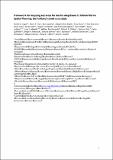Files in this item
Framework for mapping key areas for marine megafauna to inform Marine Spatial Planning : the Falkland Islands case study
Item metadata
| dc.contributor.author | Augé, Amélie A. | |
| dc.contributor.author | Dias, Maria P. | |
| dc.contributor.author | Lascelles, Ben | |
| dc.contributor.author | Baylis, Alastair M.M. | |
| dc.contributor.author | Black, Andy | |
| dc.contributor.author | Boersma, P. Dee | |
| dc.contributor.author | Catry, Paulo | |
| dc.contributor.author | Crofts, Sarah | |
| dc.contributor.author | Galimberti, Filippo | |
| dc.contributor.author | Granadeiro, Jose Pedro | |
| dc.contributor.author | Hedd, April | |
| dc.contributor.author | Ludynia, Katrin | |
| dc.contributor.author | Masello, Juan F. | |
| dc.contributor.author | Montevecchi, William | |
| dc.contributor.author | Phillips, Richard A. | |
| dc.contributor.author | Pütz, Klemens | |
| dc.contributor.author | Quillfeldt, Petra | |
| dc.contributor.author | Rebstock, Ginger A. | |
| dc.contributor.author | Sanvito, Simona | |
| dc.contributor.author | Staniland, Iain J. | |
| dc.contributor.author | Stanworth, Andrew | |
| dc.contributor.author | Thompson, Dave | |
| dc.contributor.author | Tierney, Megan | |
| dc.contributor.author | Trathan, Philip N. | |
| dc.contributor.author | Croxall, John P. | |
| dc.date.accessioned | 2019-09-02T23:39:21Z | |
| dc.date.available | 2019-09-02T23:39:21Z | |
| dc.date.issued | 2018-06 | |
| dc.identifier | 252459295 | |
| dc.identifier | daf97979-fc0d-462e-a32a-8637f85bd507 | |
| dc.identifier | 85043315597 | |
| dc.identifier | 000430765100008 | |
| dc.identifier.citation | Augé , A A , Dias , M P , Lascelles , B , Baylis , A M M , Black , A , Boersma , P D , Catry , P , Crofts , S , Galimberti , F , Granadeiro , J P , Hedd , A , Ludynia , K , Masello , J F , Montevecchi , W , Phillips , R A , Pütz , K , Quillfeldt , P , Rebstock , G A , Sanvito , S , Staniland , I J , Stanworth , A , Thompson , D , Tierney , M , Trathan , P N & Croxall , J P 2018 , ' Framework for mapping key areas for marine megafauna to inform Marine Spatial Planning : the Falkland Islands case study ' , Marine Policy , vol. 92 , pp. 61-72 . https://doi.org/10.1016/j.marpol.2018.02.017 | en |
| dc.identifier.issn | 0308-597X | |
| dc.identifier.other | RIS: urn:F2260B738F3B28CFB9266513BFBDF3E0 | |
| dc.identifier.other | ORCID: /0000-0003-1546-2876/work/56862196 | |
| dc.identifier.uri | https://hdl.handle.net/10023/18407 | |
| dc.description | This study was funded by the Department for Environment, Food and Rural Affairs UK as part of the Darwin Plus project DPLUS027 (Marine Spatial Planning for the Falkland Islands). JFM received financial support during this study from the German Research Foundation (DFG SPP 1158, MA2574/6–1). JPG received financial support during this study from FCT - Portugal through the strategic project UID/AMB/ 50017/2013 and from FEDER funds granted to CESAM, within the PT2020 Partnership Agreement and Compete 2020. | en |
| dc.description.abstract | Marine Spatial Planning (MSP) is becoming a key management approach throughout the world. The process includes the mapping of how humans and wildlife use the marine environment to inform the development of management measures. An integrated multi-species approach to identifying key areas is important for MSP because it allows managers a global representation of an area, enabling them to see where management can have the most impact for biodiversity protection. However, multi-species analysis remains challenging. This paper presents a methodological framework for mapping key areas for marine megafauna (seabirds, pinnipeds, cetaceans) by incorporating different data types across multiple species. The framework includes analyses of tracking data and observation survey data, applying analytical steps according to the type of data available during each year quarter for each species. It produces core-use area layers at the species level, then combines these layers to create megafauna core-use area layers. The framework was applied in the Falkland Islands. The study gathered over 750,000 tracking and at-sea observation locations covering an equivalent of 5495 data days between 1998 and 2015 for 36 species. The framework provides a step-by-step implementation protocol, replicable across geographic scales and transferable to multiple taxa. R scripts are provided. Common repositories, such as the Birdlife International Tracking Database, are invaluable tools, providing a secure platform for storing and accessing spatial data to apply the methodological framework. This provides managers with data necessary to enhance MSP efforts and marine conservation worldwide. | |
| dc.format.extent | 2440859 | |
| dc.language.iso | eng | |
| dc.relation.ispartof | Marine Policy | en |
| dc.subject | Marine conservation | en |
| dc.subject | MSP | en |
| dc.subject | Patagonian Shelf | en |
| dc.subject | Seabirds | en |
| dc.subject | Seals | en |
| dc.subject | South Atlantic | en |
| dc.subject | Tracking data | en |
| dc.subject | QH301 Biology | en |
| dc.subject | 3rd-DAS | en |
| dc.subject | SDG 14 - Life Below Water | en |
| dc.subject.lcc | QH301 | en |
| dc.title | Framework for mapping key areas for marine megafauna to inform Marine Spatial Planning : the Falkland Islands case study | en |
| dc.type | Journal article | en |
| dc.contributor.institution | University of St Andrews. School of Biology | en |
| dc.contributor.institution | University of St Andrews. Sea Mammal Research Unit | en |
| dc.contributor.institution | University of St Andrews. Marine Alliance for Science & Technology Scotland | en |
| dc.contributor.institution | University of St Andrews. Scottish Oceans Institute | en |
| dc.identifier.doi | 10.1016/j.marpol.2018.02.017 | |
| dc.description.status | Peer reviewed | en |
| dc.date.embargoedUntil | 2019-09-03 |
This item appears in the following Collection(s)
Items in the St Andrews Research Repository are protected by copyright, with all rights reserved, unless otherwise indicated.

